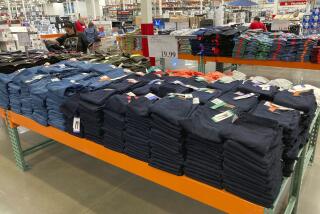Learning to Hunt for the Big Game: Bargains
- Share via
Most women know that a good deal hinges on more than a deep discount. In fact, they seem to have a genetic predisposition for finding quality merchandise on sale.
Men, though, still tend to be bumblers at the business of bargain hunting, fashion experts say. Plop them down in a department store mid-January amid the written promises of 30% to 60% off and . . . well, it’s not pretty.
“Women are much faster at shopping on sale and go in with a shopper’s attitude, whereas men go in thinking, ‘Well, maybe I’ll find something,’ ” says Kelly Bevan Spirer, fashion director at Saks Fifth Avenue. “Men need to focus on why they are there. And if [a man’s] going to shop sales, he should first ask himself if this is something he really needs in his wardrobe and then consult with a sales associate to avoid making mistakes.”
The biggest mistakes generally include settling for a lower-priced but ill-fitting garment or inferior fabric, failing to comparison shop and falling into the two-for-the-price-of-one trap.
First and foremost, a man (or woman, of course) should never buy anything just because it’s a great price, says David Chu, designer for the menswear label Nautica. “If you have a choice of buying a $20 turtleneck you’re going to wear only once because it doesn’t fit right or a $40 turtleneck you’re going to wear eight or nine times, the $40 one is the better buy.”
Massimo Iacoboni, fashion director of the New York-based Fashion Assn., which showcases trends for the press, agrees. “Always buy the most expensive item in the market at the lowest price,” he says. “Luxury items--perhaps some designer label you’ve always wanted--are a good thing to buy on sale because most of us can’t afford to own them at full price. Because they are better quality, by and large I think they last longer and are therefore the better bargain.”
So go ahead and splurge on that $400 cashmere sweater marked down to $200. The payoff will be worth it: “Cashmere sweaters are great because they are functional under a suit, good for evening as an option to a shirt and tie and great as layering pieces for the weekend, especially if you’re going somewhere colder than we are,” Spirer says.
*
Men should also know that the only way to be sure of snagging a bargain is to do something many of them loathe: Shop around. Advertised sale prices are not always the lowest.
For example, some stores buy discounted merchandise from apparel makers’ overstocked warehouses, mark the tag at full price, then advertise a 30% discount before even putting it on the floor. So, the $60 silk shirt “slashed” to $40 may have cost the store $20, which translates into a 100% gain. Meanwhile, another retailer may have the same silk shirt priced a whole lot closer to the apparel maker’s $20 tag.
In addition to snatching up luxury items, experts suggest purchasing a fashion item you might not otherwise try, such as a banded-collar shirt. “You don’t want to pay full price until you’re sure that it’s the right look for you and it feels comfortable to wear,” Iacoboni says.
Still, use caution when experimenting. Don’t get too trendy.
“You have to be careful buying trends on sale,” Spirer says. “Because usually by the time it goes on sale it’s out of style.”
And don’t assume that such wardrobe basics as lightweight sweaters, leather loafers and cotton dress shirts are a good buy just because they’ve been discounted.
“We never put our basic white dress shirts on sale because we know the consumer wears them frequently,” says John Carroll, owner of Carroll & Co., a traditional men’s store in Beverly Hills. “Often, stores bring in white shirts for sales which are cheaper than they normally sell, so a guy may think he’s getting a good deal when what he’s getting is a cheap shirt.”
A better idea is to look for a dress shirt that has been either unfolded or removed from its original plastic wrap. Many stores take off up to 50% on such otherwise untainted items. “Customers shouldn’t worry if a shirt has been opened or looks shopworn, because after one trip to the dry cleaner it looks new again,” Carroll notes.
As for other staples, good buys this month might include long-sleeve thermal shirts at Eddie Bauer for $28 or merino wool turtlenecks at the Gap for $19.99. To judge the merit of an individual item, compare its fabric to that of similar non-sale merchandise in the same store, experts say. Also, look for flaws in stitching, inside and out, and read the label. Natural fibers will hold up better than blends, and “if it says made in Europe or in this country, chances are it’s better than if it was mass-produced in the Orient,” Carroll says.
Similar advice applies when shopping for high-ticket items. Most men need at least two good suits (black and navy) and several sport coats in their wardrobes, and sales are a good way to replenish the supply. But it’s probably a good idea to avoid “two-for-the-price-of-one” offers.
Here’s why: Most suits sell for about three times the production cost. If a store can afford to sell two suits for $250, either it is taking a major loss (how likely is that?) or you’re buying suits that cost about $42 each to make. In most cases, you get what you pay (or don’t pay) for.
Likewise, never buy a sport coat made of silk or polyester if you can afford to pay the little bit more for wool. “It’s a myth that if you find a suit that is wool/nylon or wool/ polyester at a lower price you’re getting a better deal,” Carroll says. “An all-wool suit is usually not that much different in price, but it’s a better investment because it’s softer, cleans better, holds its shape longer and is overall more comfortable to wear.”






